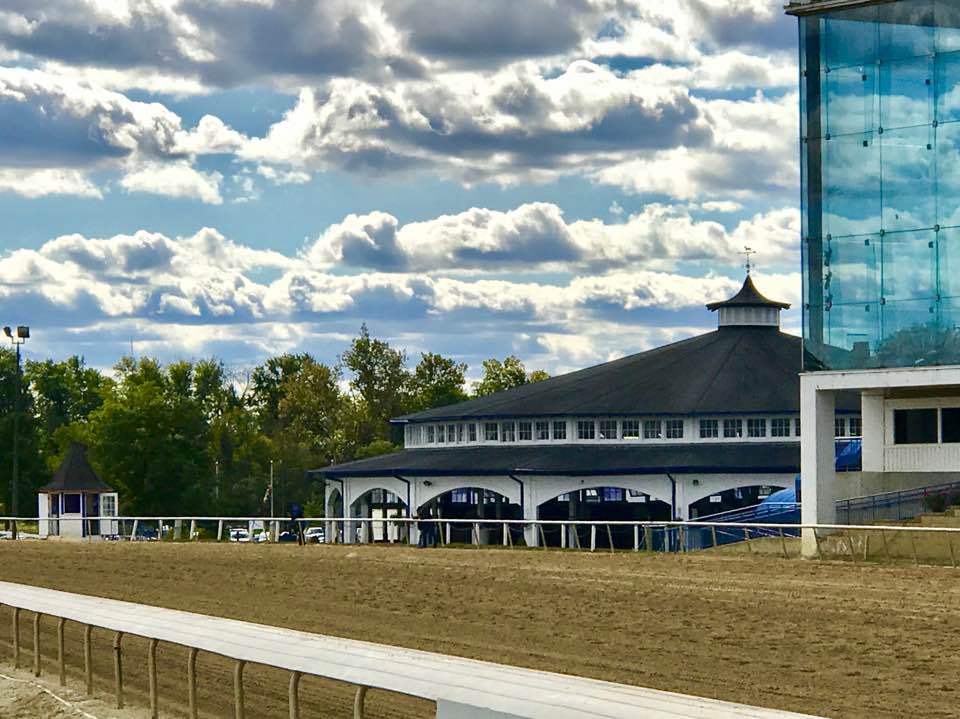
Photo of Laurel Park by Dottie Miller
By Maribeth Kalinich
UPDATED 1/19/2022 3:55 PM
The Maryland Stadium Authority (MSA) was mandated by law to deliver two reports to the Maryland General Assembly on the progress of the rebuilding of Pimlico Race Course and Laurel Park under HB 897. The first was produced in September 2022. The second due to the Assembly Jan, 1, 2023.
We previously reported that MSA did not deliver the second part of the report to the Assembly on Jan 1, 2023, as specified by the law. That information was incorrect per an email received today from a representative of MSA to Past The Wire.
MSA did deliver the second report on time to the Assembly. Here is a statement MSA sent via email to Past The Wire. We will publish a separate article regarding the second MSA report as soon as possible.
The Maryland Stadium Authority (MSA), as directed by HB 897, Economic Development – Sports Entertainment Facilities and Event, Prince George’s Co. Blue Line Corridor Facilities and Racing Facilities, submitted a preliminary report of the findings from studies of both the Pimlico and Laurel Park racing facilities to the legislature in September 2022, with the final report submitted in January 2023. Since the final report speaks for itself, the MSA has no further comment at this time and respectfully requests Marylanders and those interested in the racing initiatives to refer to the report.
For easy reference, the link to the report below.
Maryland Stadium Authority Report on the Pimlico and Laurel Park Racing Facilities Redevelopment as Required by HB 897 / Ch. 61, Sec. 3(a), 2022 (MSAR #14166)
https://dlslibrary.state.md.us/publications/Exec/MSA/HB897Ch61(3(a))(2022)_2023.pdf
An additional report accompanied the MSA Report in September. Maryland Economic Development Corp. (MEDCO) provided their own report regarding Laurel Park. We will review that report but first, take a brief look at where Pimlico stands
With Pimlico, there still remain many agreements that need to be met before the ownership can be transferred for the bonds to be issued.
This was a particularly interesting paragraph. In 2016, the Maryland Jockey Club sold a “more than 20 acre” parcel of Pimlico to Sinai/Lifebridge for $10 million. It was an overflow area where trainers parked trailers and there was Preakness parking.
Sinai has wanted the parcel for about a year, where about 600 Sinai employees park on weekdays, but that they have agreed to vacate the lots during Preakness.
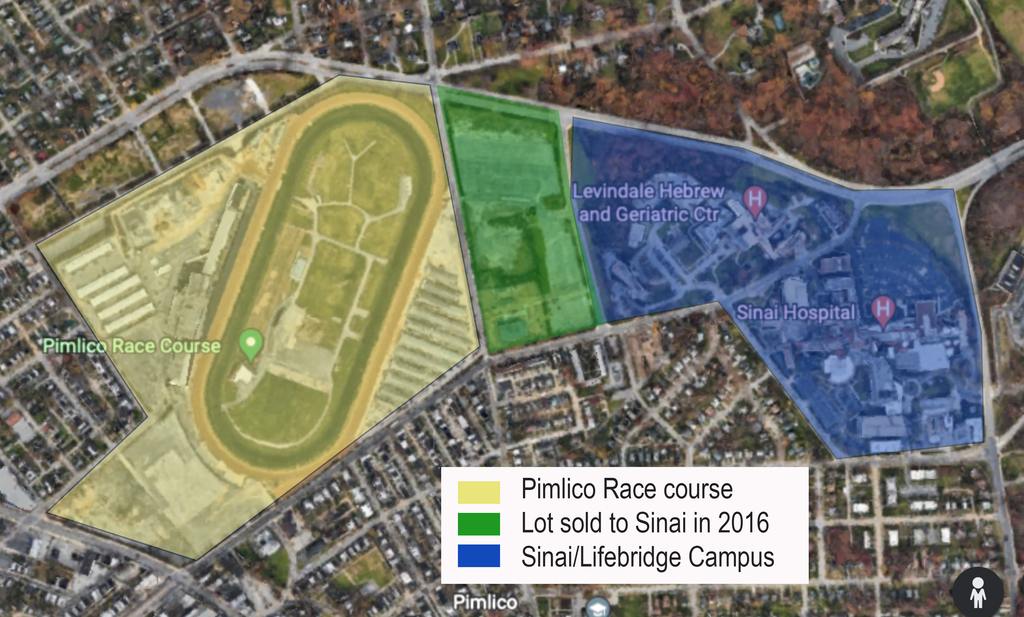
When the news broke it raised concerns. Bill Cole, then president of the Baltimore Development Corporation and one of the creators of the new Laurel/Pimlico plan said at the time to the Baltimore Sun “I’ve asked the question very directly and been assured repeatedly that it does not in any way affect the future of Preakness or Pimlico. If I thought for one second that it would have an adverse impact on the future of Pimlico, there’s no way that we’d be standing by idly, letting this happen.”
There will be no Preakness parking on this parcel either.
In 2020 it was announced that: “LifeBridge Health has broken ground on a $12M, 32,000 sf facility – the “Center for Hope” – near Pimlico race course. LifeBridge states that the Center, which will open in 2022, is designed to welcome children, youth and adults into a space that fosters hope, safety and wellness. LifeBridge’s plans for the more than 20 acre site near their Sinai Hospital campus also include a $100M, 100,000 sf outpatient care center, and a bioincubator to foster research and science technologies that could spin out biotech companies, according to Baltimore Business Journal.”
And it did: “LifeBridge Health celebrated the opening of the Jill Fox Center for Hope with a ribbon-cutting ceremony on May 4, 2022.”
From the MEDCO Report: Laurel Park can serve as the primary year-round Thoroughbred horse racing operating in Maryland. After the Maryland Jockey Club sold off portions of the Pimlico property to Lifebridge Health nearly a decade ago. Laurel Park is a location where all significant Maryland racing operations can be consolidated.”
In my opinion this is stating that one of the reasons Pimlico is not viable as the primary location is because 20 acres was sold not nearly a decade ago but merely just over six years ago.
Before we switch gears, let’s go back to 2012 with an excerpt from the MEDCO Report: The Racetrack Facility Redevelopment Account (RFRA) and the Purse Dedication Account (PDA)
“The Maryland Jockey Club receives significant operating assistance from the Maryland Thoroughbred Horsemen’s Association and the Maryland Horse Breeders association under a formally agreed to “10-year Agreement” adopted in 2012. The two associations agreed to provide the Maryland Jockey Club with a portion of its parimutuel wagering revenues, an operating subsidy of approximately $8 million per year. The agreement spells out a minimum of 142 racing days yearly at Laurel and Pimlico combined.
That agreement expired in December 2022.”
Laurel Park’s Story
Regarding Laurel Park, they also at a stalemate. There would be excessive capital gains taxes on the bonds if Laurel remains privately owned. In the MEDCO study, they examine the possibility of private ownership of Laurel Park in order to qualify for the bonds on a tax-free basis.
There are other issues with Laurel Park. The MEDCO report mentions wetlands several times. The wetlands make development of the Laurel property a delicate matter.
In order to construct all of the structures necessary to make Laurel not only the main racing facility but essentially the only racing facility more land is necessary.
MEDCO is asking the The Stronach Group add an adjacent lot they own on Brockbridge Road for any structures that cannot be built on the current Laurel property due to the wetlands.
MEDCO Report: “While the footprint of the main Laurel Park parcel is significant (229 acres), much is wetlands and undevelopable. The adjacent 58-acre Brock Bridge Road property should be considered key to the overall horse-centered development and can be used to accommodate upgraded backstretch facilities.”
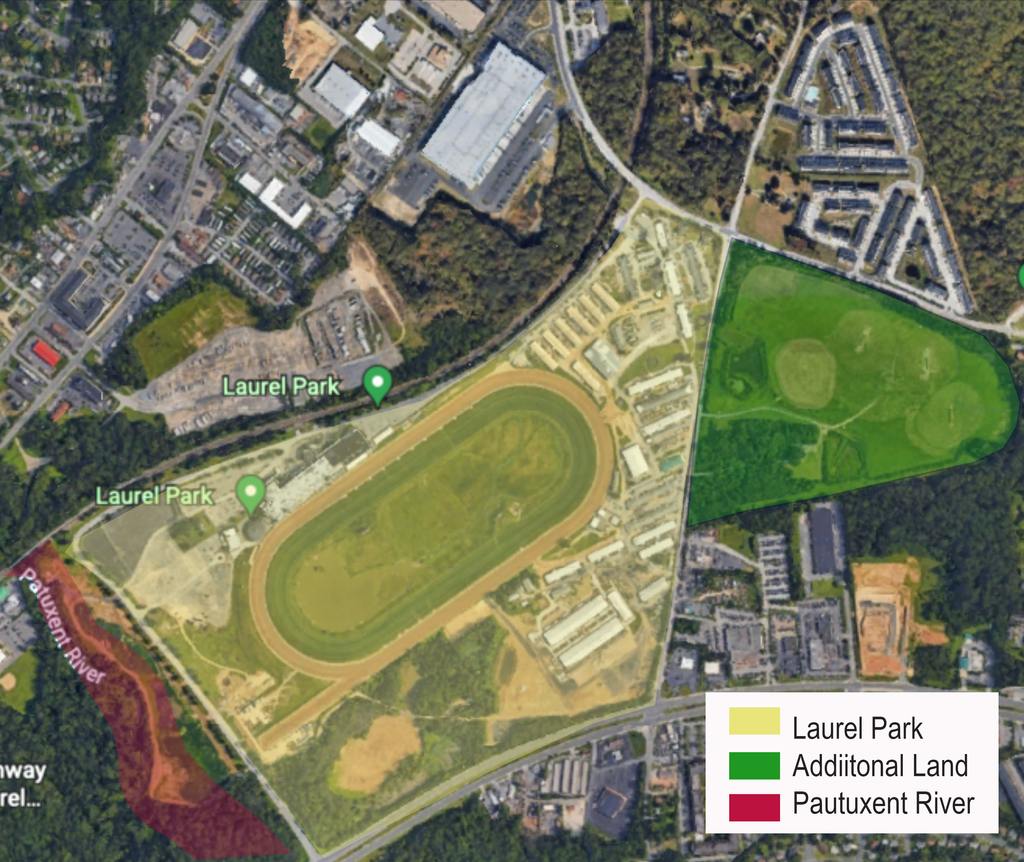
Another issue is cost. The cost estimates were made three years ago, and it is now said that the amount of the bonds earmarked for Laurel Park will not cover the current plans.
Laurel Park was allocated $155 million in bonds for upgrades/rebuilding by the Maryland General Assembly in the Racing and Community Development Act of 2020. The plans are to build a full year-round racing and training facility with three tracks—dirt, tapeta and grass. A new open grandstand rendering was presented and there are new barns, dorms, a paddock and other outbuildings planned.
The existing paddock, part of historic Laurel, will remain and used in some capacity.
MEDCO’s report states Laurel Park’s location – roughly halfway between Washington, D.C. and Baltimore City – makes the area appealing to commuters. The area north and east of the racecourse is suburban in character, consisting of medium density single-family housing development with commercial businesses along arterial roadways such as MD-198 and Washington Boulevard
It also states: “Despite some site shortcomings, Laurel Park is situated in a generally attractive location, given its situation between the large, urbanized centers of Baltimore and Washington D.C., and its history in the racing industry.”
Below is an update of Laurel Park with edited excerpts of the MEDCO Report.
Current conditions at Laurel Park
The main portions of the Laurel Park clubhouse and grandstand date to 1911 and 1951 and are too large for current needs and beyond their usable life. Demolition or significant and costly renovations would be required for the customer facing structures.
Backstretch stalls, barns and staff housing are in generally poor condition, with significant code
The future state of Laurel Park
The Maryland Stadium Authority (MSA), in direct and frequent consultation with the Maryland Thoroughbred Horsemen’s Association, the Maryland Horse Breeders Association, the Stronach Group and others, has developed feasible plans that include upgraded backstretch operations and an appropriately sized grandstand clubhouse area that can fulfill the mission of Laurel Park serving as a world-class year-round thoroughbred center.
- To fulfill that function, barns, stables, tracks and staff housing in particular must be of a high- quality. There is a projected need for approximately 1,100 horse stalls immediately and up to 1,600 stalls at full build-out to accommodate the expected peak Maryland thoroughbred racing population. The Brock Bridge property is the most feasible option for rebuilt backstretch operations.
- A newly constructed Laurel Park should include quality housing for staff that care for horses, to replace units in poor condition. The Maryland Department of Housing and Community Development has been involved in discussions to participate in this effort.
- Backstretch operations should be constructed first, and immediately, but must be closely coordinated with the work at Pimlico to ensure that there is always a facility available for training and racing during construction. It may be possible to proceed and complete the new racing ovals at Pimlico while design work continues at Laurel Park.
- Permanent facilities do not need to be as large as existing structures. Temporary overlay can be used for special events to reduce the operations and maintenance of fixed facilities.
- Current revenues for racing purses – approximately $70 million – are a solid foundation for racing operations. There is a significant potential for a right-sized and horse-centered Laurel Park to be at a minimum a break-even proposition, anticipated sometime over the next five (5) years.
- A redevelopment of a Thoroughbred center will complement surrounding economic development activity in the Laurel Park area, making MEDCO involvement logical and appropriate.
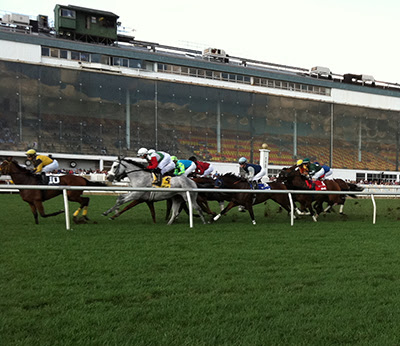
Complications with Negotiations
Currently, there is a stalemate between the current owners, The Stronach Group (TSG) operating as the Maryland Jockey Club (MJC) and the State of Maryland. The issue is capital gains taxes that would be due on the bonds in the amount of $40 million.
Originally, the plan was for the owner to divest itself from both Pimlico and Laurel Park before the bonds were issues. However, the owner was reluctant to relinquish the Laurel Property.
One factor could be because The Stronach Group is currently involved in a major residential development project known as Paddock Pointe to the east of Laurel Park, in close proximity to the Laurel MARC station.
We were originally led to believe that the property would convey, i.e., be turned over in fee simple, to Anne Arundel County or another government entity or another tax-exempt organization. Pimlico was conveyed to the City of Baltimore who in turned it over to the MSA.
TSG would now like to offer the Laurel Property or at least part of it, to government entity or another tax-exempt organization, for a yet to be determined price.
As recently reported by the Baltimore Sun, as a private company receiving state money for improvements at Laurel, Stronach would need to pay roughly $40 million in federal taxes, which Alan Rifkin said is “just not tenable.”
Rifkin said this spring that an initial effort to insulate the spending from the tax wasn’t successful and stakeholders were looking for a solution. He raised the prospect at that time of Stronach conveying Laurel to a government entity or another tax-exempt organization.
Now, a MEDCO. report to the legislature says a public or nonprofit entity will need to buy Laurel Park for the project to proceed.
In coordination with local government officials, consideration should be given to the creation of a Tax Increment Financing district in the Laurel Park area to facilitate improvements to the Laurel MARC station.
This would attract additional private sector investment in new “mixed-use” commercial/residential development around Laurel Park, that supports the surrounding community, the racing industry and its patrons.

Additional issues
The estimated cost of construction work has grown significantly since 2020, due to the changing needs and desires of the ownership group and the horse industry, as well as an overall inflation in trades and building related costs. While SB987/Chapter 590 provided an anticipated $155 million in bonding authority for Laurel Park (as part of the overall $375 million in bonding authority for the combined Pimlico and Laurel Park projects) the current cost estimate of all programmatic needs greatly exceeds that amount.
Laurel Park is the largest horseracing facility in Maryland. The facility opened to the public in 1911, and original structures remain as part of the clubhouse and grandstand complex.
Laurel Park is owned and operated by the Maryland Jockey Club, which is a subsidiary of The Stronach Group and its racing operating 1/ST Racing. The Maryland Jockey Club was founded in Annapolis in 1743, 30 years before the Revolutionary War, and is chartered as the oldest sporting organization in North America. After 267 years, it remains the corporate name of the company that operates Pimlico Race Course in Baltimore, which opened in 1870, as well as Laurel Park Racecourse in Laurel, Maryland which opened in 1911.
The Stronach Group, based in Aurora, Ontario, Canada, first purchased a majority interest in the Maryland Jockey Club in 2002, and expanded its interests in 2007. In addition to Laurel and Pimlico, the group owns several Thoroughbred racetracks, including Santa Anita (CA), Golden Gate Fields (CA) and Gulfstream Park (FL). The Stronach Group also operates the simulcasting venues at these tracks, as well as OTB (Off-track betting) facilities. Other ventures include Xpressbet, an advance deposit wagering business that allows customers to bet on over 100 horse racing tracks via internet or telephone.
The group rebranded its racing facilities as an entity known as 1/ST Racing, in 2020. The CEO of 1/ST Racing is Craig Fravel, who is formerly President and CEO of Breeders’ Cup Limited, and was President and General Manager of Del Mar.
Under the corporate structure currently in place, Laurel Racing Association Limited Partnership owns the real property and other assets comprising Laurel Park. The Association consists of the general partner, Laurel Racing Association, Inc., and the limited partner, Maryland Racing, Inc. (MRI). MRI, through its wholly owned subsidiary MJC Racing (2007) LLC, owns a 100% voting and equity interest in the Association and Pimlico Racing Association, Inc. (“Pimlico”). The Stronach Group through its subsidiary TSG Developments Investments, Inc. (the Parent), ultimately owns a 100% equity interest in MRI. The Association and Pimlico are collectively referred to as The Maryland Jockey Club.
Stronach Group has been an active participant in redevelopment efforts adopted by the General Assembly in 2020 as SB 987.
The size of the main property is 229 acres and sits entirely in Anne Arundel County. An adjacent 58-acre parcel, the Brock Bridge Road property, is owned by the Jockey Club corporate parents and is available for racing operations.
The 1911 grandstand structure is connected to a clubhouse built in 1959, and the combined facility is enclosed in a glass curtain wall erected in the 1960s.’
Backstretch operations consist of 45 structures, some dating to 1938, including barns, dormitories, a kitchen and other support structures.
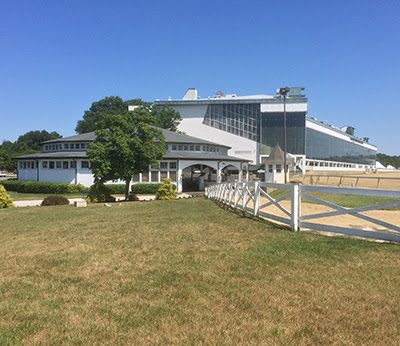
MSA’s Laurel Plan and Evaluation
The Maryland Stadium Authority, under SB 987, initiated efforts to create a feasible horse- racing centered re-development plan for Laurel Park and commissioned consultants to evaluate all physical aspects of the Laurel Park site and structure. A detailed report, including a 135-page facilities assessment prepared by ASG (Ayers Saint Gross) and Populous, has been reviewed by MEDCO staff.
The report evaluates the overall site, as well as the following components: structural frame, exterior envelope, roof, HVAC, plumbing, fire protection, electrical power, lighting, fire alarm, interior finishes, vertical transportation, life safety and accessibility and food service.
Structures and systems have been evaluated in the 1953 clubhouse, the 1911 grandstand, the 1966 curtain wall, as well as the backstretch barns and kitchen and paddock. Notable areas of concern have been found in all portions of the property.
In the basement area below the 1911 grandstand structure, there are excavated areas with shoring posts, but several shoring posts appeared to have fallen loose and not engaged with the slab above. Significant concrete distress is visible at the underside of the concrete slab, with corrosion of steel reinforcement.
Additions or renovations to the structures would pose a challenge. A 2017 study by the firm ECS on five concrete columns in the 1911 grandstand found that the reinforcement does not meet the minimum required by the current building codes, and thus the columns would need to be replaced if affected by added gravity or lateral loading from an alteration or addition.
The curtain wall shows evidence of leakage, missing and misplaced shims, and is in overall poor condition with several major repair needs, and deficiencies identified. Significant signs of water management issues were identified requiring likely major repairs or replacement.
The report provides an overall rating index for each element of the facility and components systems, ranging from 1 to 5, corresponding to a description of excellent, good, fair, poor or bad. All component systems were found to have major deficiencies which place them beyond repair.
Equipment in the Grandstand (1911) Building is failing and generally not suitable for re-use.
Plumbing systems are deteriorating and the fire protection systems at the Grandstand (1911) Building and the Clubhouse (1953) Addition do not provide full coverage.
The backstretch buildings can be grouped into four categories: horse barns, wash barns, dorms, and common facilities buildings. Backstretch buildings contain minimal to no fire protection systems and minimal HVAC. Consultants have recommended demolishing all.
Housing facilities for workers that care for horses are in generally poor condition, and beyond their usable life. For health and safety reasons, these housing units should be demolished and replaced with high-quality structures that meet current codes and all applicable standards.
Several backstretch buildings were constructed without building permits and have drawn the attention of the State Fire Marshal and Anne Arundel county officials.
Notices were issued related to “dummy” hydrants in barn areas that are either not connected to water or do not contain adequate water flow for suppression. Violation notices state that barns did not undergo proper site development review, which would be necessary for violations to be resolved.
Of note, interior finishes in public facing areas are in excellent to good condition given recent renovations, including restaurants on clubhouse level and related lounges and common spaces.
There are portions of the property where preservation is recommended. An Historic Saddling Paddock structure is considered in good condition. Constructed in the 1920s or early 1930s, it is eligible for listing on the National Register of Historic Places for its representation of a distinctive architectural typology, and the building therefore contains many original and distinctive features.
Overall, however, it is the assessment of MEDCO real estate/development staff that the structures at Laurel do not warrant additional investment, and demolition is the logical next step.
The structures as currently configured would most likely not be used as part of an updated racing operation.
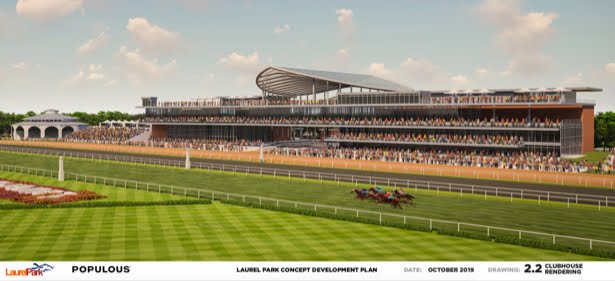
Preliminary operational and financial analysis
When Laurel Park is reconstructed as the center of racing operations, priority must be placed on the provision of a quality product: the most talented horses, primarily Maryland-bred horses, competing in races with top purses, and a customer base that is drawn to those races, with income streams supplemented by simulcasting, food and beverage and legalized sports wagering.
A review of financial information shows that Laurel Park operated with a loss from operations of $5.78 million in 2016 and $10.1 million in 2019, prior to the onset of coronavirus pandemic, which created more economic uncertainty.
Currently, approximately $70 million per year is generated for purses in Maryland, or more than $350,000 per race day.
Pursuant to the 10-year agreement with the Stronach Group, $8 million annually is diverted from parimutuel purse fund revenues to cover operational shortfalls. The agreement expires Dec. 31, 2022. According to preliminary analysis, there is reason to believe that the $70 million annual overall purse structure has room for growth, and the basic purse structure is adequate to support a strong racing and breeding industry.
Operating advantages already in place (parimutuel gaming and revenue from the Preakness Stakes and other large-scale racing events) could lead to at least a breakeven situation, not an annual loss of tens of millions of dollars.
The Maryland Thoroughbred Horsemen’s Association assistance helps offset operational losses to underwrite the expense of more live race dates. Accounting for the horsemen’s contribution, OTB income and other income, the net loss from 2016 to 2019 averaged roughly $1.5 million per year. These auxiliary income streams must be considered when assessing full financial viability of a Thoroughbred site.
The Maryland Thoroughbred Horsemen’s Association
Leadership of the Maryland Thoroughbred Horsemen’s Association indicate the organization would welcome an ownership change at Laurel Park.
The Association is supportive of a new structure, e.g., a non-profit organization, possibly created by the State of Maryland, to operate horseracing activities.
The Association is particularly interested in investments to the backstretch of Laurel, noting a need for up to 1,600 stalls to accommodate the consolidation of horse training activities from Pimlico and Bowie to Laurel.
The Association supports and advocates for the installation of a new synthetic track surface for training and holds that this surface is necessary for a full training program.
There is acknowledgement that sequencing with Pimlico is critical.
The Maryland Horse Breeders Association
The breeders maintain that good conditions for facilities and racetracks are critical to industry success. Tracks must be high quality and safe for horses and jockeys.
Breeders’ view on Laurel is that backstretch barns need to be of high quality and meet full current standards for horses and those who care for them. HVAC systems must be current for staff health, and horses must also be kept in an environment that is healthy for them; additionally, good quality facilities are necessary for staff that care for horses and live close by.
Breeders agree that the current front-side facilities (clubhouse and grandstand) are much larger than need be, and also agree that while some large-event racing days can attract 15,000 fans or more (e.g. Maryland Million Day) those crowds could be accommodated in quality, temporary structures for events. Sufficient customer parking must be available at the site for larger events, estimated at approximately 4,000 spots.
Breeders note that nationally, the horse population is dwindling, mostly due to the cost of raising the animals. The national thoroughbred foal crop has dropped by about half in the last two decades.
Horse breeding continues to be fairly strong in Maryland and is on the upswing. The state’s 2021 foal crop was 613, up from 393 in 2011, a 64% increase. With the overall North American foal crop in decline, Maryland is the only major breeding state that has shown an increase over the last 10 years. The Maryland foal crop is now ranked seventh among states, up from 13th in 2011. Maryland bred horses now account for 46 percent of top finishers in state races.
To maintain this position, racing needs to continue to be incentivized through dedicated revenues, as currently occurs.
Breeders agree that a non-profit ownership model is needed and would be beneficial and would help ensure that money from Maryland racing stays in Maryland.
The Maryland Racing Commission
The Commission agrees that renovations are desperately needed at Laurel, and further agrees that the Laurel grandstand facility is too large for current needs.
The Commission sees value in sizing facilities to meet industry needs, citing Colonial Downs in Virginia as a template.
The Commission acknowledges that nationwide, the number of Thoroughbred foals has been on the decline, ultimately affecting the number of racehorses.
Under a new non-profit ownership and operating model, a break-even or profitable thoroughbred racing operation would be possible and sustainable.
The Maryland Stadium Authority
The MSA has worked diligently since the adoption of SB987 in 2020 to plan and program for full operational improvements to Laurel Park, as well as to Pimlico.
MSA has retained known and respected planning and design consultants – Ayers Saint Gross (ASG) and Populous (which has a racing and athletics specialty) – to evaluate and design facilities.
MSA has worked collaboratively with the Maryland Thoroughbred Horseman’s Association, the breeders, and the Stronach Group/1/ST to take all needs into account to develop a facility plan and program.
As it has undertaken its evaluation, MSA has documented a variety of life-safety violations in the backstretch area of Laurel Park, as well as environmental violations related to wetlands areas that are part of the property. Wetlands and sensitive areas, including water retention areas in the track infield, pose significant constraints on development of the property.
Laurel Park’s location – roughly halfway between Washington, D.C. and Baltimore City – makes the area appealing to commuters. The area north and east of the racecourse is suburban in character, consisting of medium density single-family housing development with commercial businesses along arterial roadways such as MD-198 and Washington Boulevard
Summary of Discussions and Requests by The Stronach Group
The Stronach Group and 1/ST Racing have been engaged participants in the development of a renovated facility plan at Laurel Park, and their desires have been included in the programmatic planning process.
State law (via Chapter 590/SB987) has envisioned that Laurel Park property would be conveyed to a new operating entity at some point. Specifically, SB987 contains language stating “an interest in the site, in whole or in part, will be granted to Anne Arundel County or an entity or entities designated by the county at a time and on conditions established in the agreement.”
Chapter 590 also contains “requirements for and the contents of long-term agreements for management and operations at the Pimlico and Laurel Park racing facility sites.”
The Stronach Group has expressed interest in maintaining certain parcels within the Laurel Park plan for its own purposes. Under one version of a Stronach plan, all racing operations would be concentrated on the current 229-acre footprint of the Laurel Park site, and the 58- acre Brock Bridge Road property would remain outside of racing operations, and available to the Stronach Group for other “mixed-use” commercial/residential development purposes.
Additionally, the Stronach Group has sought to maintain portions of land within the Maryland Stadium Authority redevelopment footprint, including a 15.4 acre existing “clubhouse site” [made available by relocating the clubhouse from the west side of the track to the east side] and a 16.2 acre “Route 198 site.”
It is now widely understood that the Tax Cuts and Jobs Act of 2017 changed the IRS code to make grant proceeds from governmental entities to corporations taxable as gross income. IRS Section 118 would treat the MSA bond investments to redevelop Laurel Park as such a proceed, with a significant tax liability that the Stronach Group has indicated it desires to avoid.
In August, MEDCO asked Stronach Group/1/St for information on economic terms for the transfer of Laurel Park property. The company said that it would wait for information from MEDCO appraisals to drive that process.
Craig Fravel, CEO of 1/ST Racing, responded that “we have been engaged in a due diligence process with the Maryland Thoroughbred Horsemen’s Association (“MTHA”) and the Maryland Horse Breeders’ Association (“MHBA”) directed at the development of a long-term operating model for Laurel and the feasibility of various revenue sources to sustain that model.”
Fravel wrote that the company is “willing to consider the sale of both [Laurel] parcels or just the current racing parcel and expect the appraisal process you are currently conducting to be a key element of that determination.”
MEDCO’s Role In Laurel’s Future
Based on preliminary analysis to date and the economic significance of racing, MEDCO sees no immediate obstacles to its serving as the entity that could take control of Laurel Park property in an acquisition and facilitate the transition to a non-profit or agency type structure that would be committed to a racing operation and would maximize racing revenues and work to keep those revenues in the state of Maryland for the benefit of the industry.
Ultimately, as envisioned in SB987 and as being discussed by many stakeholders, a separate entity is required to ultimately control the property and operate racing in Maryland.
Discussions continue surrounding various options for a racing ownership and operational structure. They include:
A state-owned or controlled authority: a Thoroughbred Racetrack Operating Authority could be created under the state Commerce article, with members appointed by the governor and approved by the state Senate, to own and manage the primary asset of Laurel Park Thoroughbred Racing operations. Such a structure is in place in various racing facilities throughout the country and is commonly referred to as the Del Mar Model, in place at the Del Mar Racetrack in California. (Similar models in Texas and elsewhere are also under review.) These models, which are complex, involve the creation of and ownership by a governmental entity, the subsequent lease to a separate group for racing and wagering.
A non-profit organization: A non-profit entity could be formed or expanded to undertake the responsibility of managing Thoroughbred horse racing operations in Maryland.
To read the entire MEDCO report click here.




